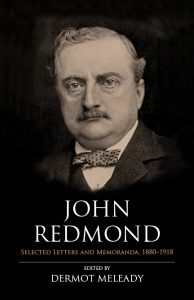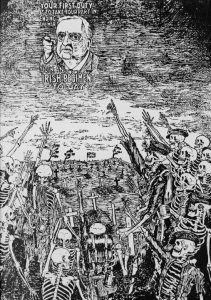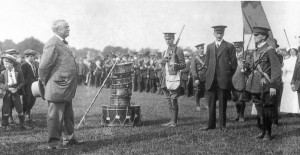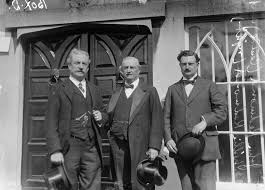Book Review: John Redmond: Selected Letters and Memoranda, 1880-1918.
 Edited by Dermot Meleady
Edited by Dermot Meleady
Published by Irish Academic Press, 2018.
Reviewer: Diarmuid Bolger
John Redmond, the Wexford-born leader of the Irish Parliamentary Party from 1900 until 1918, is one whose place in the history, and historiography, of Ireland has always been convoluted.
As Dermot Meleady makes clear by the second page of John Redmond: Selected Letters and Memoranda,1880 – 1918, much of the initial history written about the constitutional nationalist leader came from what the author calls ‘the Sinn Féin permeated political culture’.
This can perhaps be seen as one of the reasons why, after his death, Redmond never received the same level of recognition as other constitutional nationalist leaders received; most notably Daniel O’Connell and Redmond’s mentor Charles Stewart Parnell – both of whom have statues and streets named after them in the centre of Dublin.
These two men had the same advantage, in term of popular memory, as their primary nationalist opponents (the Young Irelanders/anti-Parnellites) never coming to power, meaning that their place in the historical narrative of nationalist Ireland would never become as damaged as that of John Redmond.

Throw in the unpopularity of the First World War, Irish participation in which Redmond championed, as well as the intensive post-independence effort to downplay the memory and idea of Irishmen fighting for the British Army – a stance which has now thankfully ended – this all meant that John Redmond was always going to be seen almost akin to an enemy of the fledgling independent state.
In this edited collection of Redmond’s letters, Meleady has attempted to give Redmond a form of memoir; which allows the reader the opportunity to see matters such as the Home Rule crisis, formation of the Irish Volunteers, the split in the Irish Parliamentary Party following the Parnell divorce scandal, the Easter Rising, the War movement and more through the eyes of one of the most important and later controversial political figures in the history of Irish nationalism.
In this edited collection of Redmond’s letters, Meleady has attempted to give Redmond a form of memoir through his own letters.
Through this series of letters, the reader gets an insight into the political thinking and philosophies of the man so belittled and thrown-aside after independence, yet described as ‘the idol of his race’ in 1912 by the Irish World, who also believed that ‘his place is coming to be assured in the history of Ireland. At the present time he is almost as great a figure as O’Connell and Parnell’.
It is worth saying that the letter’s presented in this text, like any primary source in history, should always be taken in the context of both their time, but also who they are written to. Letters, especially political ones like these, offer an insight into the thinking of Redmond, but they are of course tailored to their recipient, and so will often have a bias or a particular slant added in order to speak more diplomatically. However, reading through them, one can get a sense of the personality of Redmond, as well as the respect he received from many who wrote to him.
For the historian, this book perhaps does not offer the strict academic styled analysis associated with writings on Redmond; to which Meleady himself has published John Redmond: The National Leader and Redmond: The Parnellite.
However, it is the small details buried in his selection of material which makes the text so engaging. One good example that becomes increasingly apparent is Redmond’s clear animosity towards Eoin MacNeill during the Volunteer movement in 1913-1914; describing him as a man ‘unfitted for action, less fit to lead others….Eoin MacNeill is meant for a scholar’s life and for that alone’.
Eoin MacNeill, a lecturer in University College Dublin had established the Irish Volunteer Movement in November 1913 – primarily as a defence against the Ulster Volunteer Force established in January of the same year – and soon had gathered close to 150,000 men. However, with the initial provisional committee’s thirty man panel consisting of 12 (later 16) IRB men, Redmond naturally viewed this republican element with suspicion and became desperate to create a united nationalist front, based around the Irish Parliamentary Party being represented and, arguably, in control of the Volunteer movement.
Redmond thought Eoin MacNeill founder of the the Volunteer movement, was a man ‘unfitted for action, less fit to lead others…. meant for a scholar’s life and for that alone’.
In his letters to MacNeill, the tension and distrust Redmond feels towards the academic becomes apparent (during the negotiations he informed John Dillon that MacNeill is ‘a most exasperating man to deal with’ – Dillon later agrees, calling him ‘hopelessly impractical’).
However, one of the most interesting letters actually comes from Roger Casement, who is desperate to ensure that the Volunteers are armed – calling for Redmond to get a General into the Volunteers to train the men, who would then of course have the backing of the Irish Volunteers. Casement, who would famously travel to Germany with the hope of receiving weapons and a German army for the rebels during Easter Week, asks the question to Redmond of ‘what sort of Ireland will it be if “Ulster” is to keep a large armed force….and the rest of Ireland is to be without arms?’.
While this letter may present an image of Casement supporting Redmond – he also states ‘I feel that any friction between the Volunteers and yourself is a bad thing for the country’, this attitude would have changed entirely by 1915.

While visiting POW camps in Germany in an effort to recruit captured Irish soldiers to fight in “Casement’s Brigade” in the upcoming rebellion, he gave one impassioned speech which called Redmond ‘a traitor’ and attacked Home Rule. The response, instead of agreement, was for the captured soldiers to attempt to attack him, and the German sentries needing to intervene in order to protect him.
This particular story is worth referencing because it also shows the commitment of many of the Irishmen who answered Redmond’s call in 1914 to fight for the British in the War effort. His famous speech at Woodenbridge on 20 September calling on Irishmen to go ‘wherever the firing line extends’ led to the Volunteers splitting, with 92.8% voting in favour of his stance, leading to the newly-named National Volunteers.
It would be many in this small minority (named the Irish Volunteers) who the IRB would later use for their rebellion in 1916, with Joseph McGarrity writing to MacNeill to state that ‘I would rather see your committee with 5,000 adherents who were true to Ireland than 200,000 trimmers’. McNeill ironically would actually be against the rebellion and would famously call on Volunteers not to fight on the original starting date of Easter Sunday 1916.
However, by having the majority of Volunteers backing his stance, Redmond would be able to make his claim for a specific Irish Brigade to be fighting in the war, akin to the 36th Ulster Division which was largely made up of Ulster Volunteers, as well as a Home Defence in Ireland to protect the island. The letters in this text show his determination to make this a reality; informing Asquith that ‘it would be lamentable if anything were to be done to damp the rising enthusiasm in Ireland’ at the beginning of the war. He later also presented him with a memorandum entitled Recruiting in Ireland which stated that
‘the delay in the formation of the Irish Brigade….has had a most injurious and disheartening effect. For many weeks the Irish people have had paraded before them the fact that Sir Edward Carson and his friends had succeeded in obtaining an Ulster Volunteer Division…..and, on the other side, a tacit refusal on the part of the authorities to allow the formation of an Irish Brigade for the South and West’.
However, what is as interesting about the selection of letters is not just what Redmond deliberates in them, but also what topics fail to make any real appearance. The best example of this comes from the lack of discussion around the suggragette movement. Perhaps this is unsurprising; Clíona Murphy recently described him as the ‘Irish personification of anti-suffragism’, and he himself once told a delegation of the Irish Women’s Franchise League (established by Francis and Hanna Sheehy-Skeffington, as well as Margaret and James Cousins in November 1908) that he would not support the idea of votes for women.
Redmond did not support votes for women.
While most of the encounters he experienced with suffragettes were purely verbal, his physical encounters were perhaps more entertaining – including famously being hit with a hatchet thrown towards Herbert Asquith (then Prime Minister) as the two men crossed O’Connell Bridge in a carriage in on 19 July 1912.
He was also once slapped in the face and had a bag of flour poured over him while riding on a train to Newcastle in November 1913. Through reading Redmond’s letters, one can see clearly the lack of concern for this particular issue; however the problem with a text like this is that, being so strictly based around Redmond’s letters, this is an angle which cannot be properly discussed.
For the general reader, it is perhaps the section which covers Redmond’s experiences during the 1916 Easter Rising which are the most interesting. What can clearly be seen is the panic amongst the constitutional nationalist leaders as they attempted to come to grips with what was occurring.
This is perhaps most evident by the letters sent to Redmond by John Dillon; who unlike Redmond was actually in Ireland during Easter Week and as of such had a much stronger feel for the attitudes and perceptions of the Irish public as the week progressed. Perhaps most tellingly, Dillon writes to Redmond the day the Rising ends urging him to convey to the British Government the catastrophic effects that executions could cause amongst the attitudes of the public. Dillon stated that

‘The wisest course is to execute no one for the present…if there were shootings of prisoners on a large scale, the effect on public opinion throughout the country might be disastrous to the extreme. So far the feeling of the population in Dublin is against the Sinn Feiners. But a reaction might very easily be created’.
John Dillon is perhaps most famous during this period for his well-quoted speech in Westminster during the executions, where he stated that the British Authorities were ‘washing out our lives work in a sea of blood’.
However, the inevitability of these executions are actually hauntingly mirrored to Redmond by Bernard MacGillian from Chicago, who on 6 March 1916 informed Redmond that of ‘the intention…to format a ‘rising’ in Ireland next summer, which, of course, would be drowned out in blood’.
Meleady has succeeded in finally giving John Redmond his own voice in the historiography of Ireland.
Throughout this particular chapter, it is evident to see Redmond’s panic as the Rising continues, however what also becomes apparent is his desire to make interventions of behalf of some of those arrested at the end of the Rising, including MacNeill and Kathleen Lynn, the chief medical officer with the Irish Citizen’s Army during the rebellion.
However, this is not a book purely written for those with an in-depth knowledge of this period, with constant historical backgrounds contained inside every few pages, in order to give the reader a complete understanding of what is being talked about. Its content lends itself to being neither sympathetic nor damning; instead the text weaves its way through the many key political, and some more personal, moments of Redmond’s life.
While not a memoir, it still reads like one, with Redmond’s personal views appearing clear as the text progresses, and his words do not get lost in the occasional density that academic writing can sometimes produce. Ultimately, a series of letters cannot fully capture the essence of any figure, and will always be told with somewhat of a one-sided slant – even if the letters written by political enemies and oppositional characters are presented as well.
Meleady has succeeded in finally giving John Redmond his own voice in the historiography of Ireland; both for the matters he wished to discuss, and the evidence of those which he didn’t.